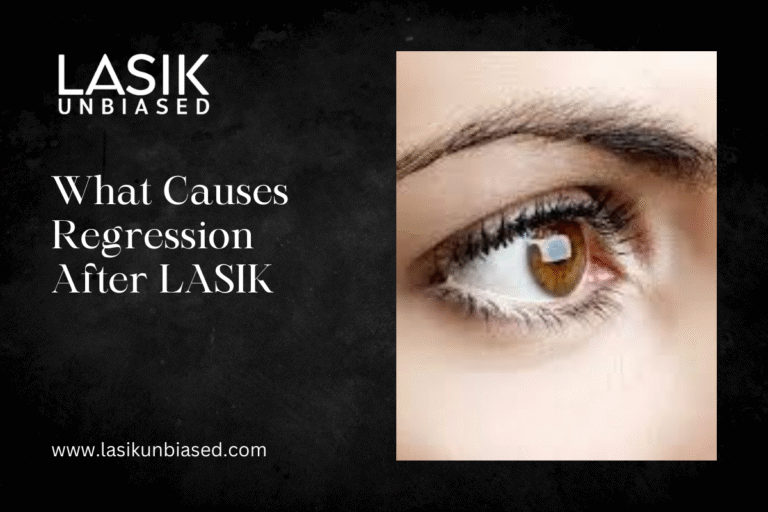Regression after LASIK is usually caused by natural healing responses or corneal biomechanics that slightly alter the reshaped cornea over time.
This can lead to a mild return of the original refractive error.
While LASIK is considered a safe and effective procedure with a high success rate, certain factors can lead to regression in some individuals.
This blog explores the primary causes of regression after LASIK, helping you understand why it occurs and how to address or prevent it.
Structural Changes in the Cornea
Corneal Healing Process
One of the most common reasons for regression is the natural healing response of the cornea. After LASIK, the body instinctively works to repair what it perceives as damage, which may slightly alter the reshaped corneal tissue. This slight thickening or remodelling can reduce the corrective effects of the surgery, leading to regression.
Corneal Elasticity and Biomechanics
The cornea’s natural elasticity affects how well it retains its new shape post-procedure. Highly elastic or biomechanically weak corneas may struggle to maintain the reshaped curvature, causing them to revert partially to their pre-surgery form. Patients with thin corneas are generally at higher risk of regression for this reason.
Overcorrection or Undercorrection
During LASIK surgery, precise adjustments are made to the cornea to correct vision issues like myopia, hyperopia, or astigmatism. However, slight overcorrection (removing too much tissue) or undercorrection (removing too little) can impact results, especially during the healing phase. This may lead to gradual deterioration in visual clarity over time.
Hormonal Changes
Pregnancy and Hormonal Fluctuations
Hormonal changes, especially during pregnancy, can temporarily alter corneal thickness and curvature, leading to transient vision fluctuations. These changes typically resolve postpartum, but it’s advisable to postpone LASIK until after pregnancy and breastfeeding to ensure stable results.
Age-Related Hormonal Shifts
Ageing brings hormonal and structural changes that can influence the biomechanics of the eye. A gradual decline in collagen and tissue elasticity with age may reduce the cornea’s ability to retain its reshaped structure, contributing to regression after LASIK.
Underlying Eye Conditions
Progressive Myopia
Patients with progressive myopia (nearsightedness that worsens over time) may experience regression post-LASIK as the condition continues to progress. Ensuring that myopia is stable before surgery is critical to minimising the risk of regression.
Keratoconus and Ectasia
Pre-existing conditions like keratoconus or the development of post-LASIK ectasia—a rare complication involving progressive corneal thinning and bulging—can lead to significant vision regression and may require specialised management. These conditions are rare but can develop in patients predisposed to corneal instability.
Lifestyle Factors
Frequent Eye Strain
Prolonged near work and insufficient outdoor activity are linked to myopia progression, which may affect long-term vision stability after LASIK, especially in younger patients. However, eye strain alone is unlikely to directly cause regression.
UV Exposure
Unprotected exposure to ultraviolet (UV) rays can weaken the corneal tissue over time, leading to vision changes. It is essential to wear UV-blocking sunglasses after LASIK to protect the eyes from light sensitivity and long-term regression.
Poor Post-Surgery Care
Neglecting post-surgery care instructions can increase the likelihood of complications. Skipping follow-up visits, improper use of prescribed eye drops, or engaging in activities that strain the eyes immediately after surgery may all contribute to regression.
Presbyopia and Age-Related Factors
Natural Ageing of the Eye
Regression after LASIK is often not due to surgical failure but may result from the natural ageing process of the eye. Presbyopia, which usually develops in the 40s or later and involves loss of near focusing ability, is unrelated to LASIK but can cause patients to feel their vision has worsened.
Genetic Predisposition
Family History of Vision Instability
Certain genetic factors can predispose individuals to progressive refractive errors like myopia or astigmatism, which may increase the risk of vision changes or regression after LASIK.
Healing Variability
Genetic differences in wound healing responses can affect corneal remodelling post-surgery, with some patients experiencing slower or atypical healing that may contribute to regression.
Managing and Preventing LASIK Regression
Comprehensive Pre-Surgical Assessment
A thorough pre-surgical evaluation is key to reducing the likelihood of regression. Surgeons assess the stability of your prescription, corneal thickness, and overall eye health to identify any risk factors. If your vision has yet to stabilise, you may be advised to wait before undergoing LASIK.
Proper Post-Operative Care
Following your surgeon’s post-op instructions diligently can significantly improve your chances of long-term LASIK success. This includes attending regular follow-ups, using prescribed medications to manage inflammation and dryness, and avoiding activities that strain the eyes during the healing phase.
Laser Enhancement Procedures
If regression occurs, options such as LASIK enhancement procedures or alternative corrective measures can be considered, depending on corneal thickness and overall eye health. These enhancements are typically considered several months or years after the initial surgery, once the cornea stabilises.
Lifestyle Adjustments
Small changes in daily habits can go a long way in preserving your LASIK results:
- Wear high-quality sunglasses with 100% UV protection.
- Maintain regular breaks from digital screens using the 20-20-20 rule.
- Avoid smoking, as it can impair healing, exacerbate dry eye symptoms, and negatively impact overall ocular health.
Exploring Alternatives
For individuals at higher risk of regression, alternative procedures like implantable contact lenses (ICLs) or refractive lens exchanges may be more suitable. Consult your ophthalmologist to discuss other options tailored to your needs.
When to Consult an Expert?
If you notice changes in your vision post-LASIK, including blurred vision or difficulty focusing, consult your eye care professional promptly. They can evaluate whether the issue stems from regression or another condition requiring attention.
LASIK Regression Is Manageable
Regression after LASIK can be disappointing, but it’s essential to understand that it doesn’t erase the success of the procedure. Identifying the causes and implementing preventive strategies can help you maintain a clear vision over the long term. Whether it’s through diligent post-operative care, lifestyle changes, or enhancements, there are ways to minimise the impact of regression.
If you’re considering LASIK or experiencing changes in your vision after the procedure, scheduling an in-depth consultation with an experienced surgeon is the first step to safeguarding your eye health and visual clarity. Your vision is worth investing in.


